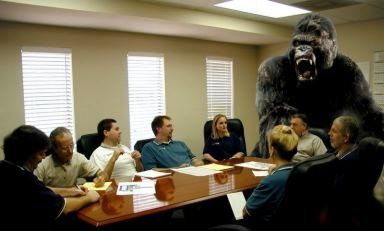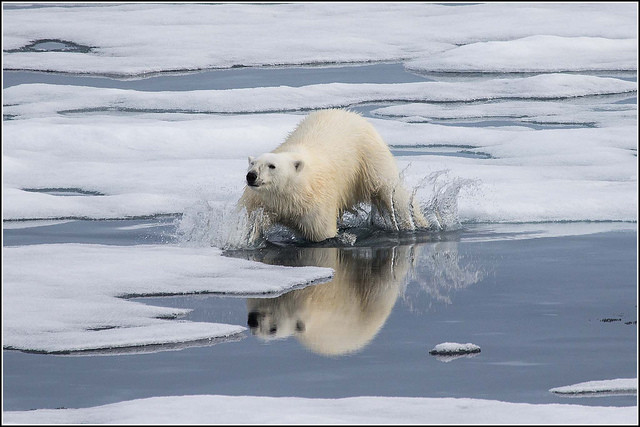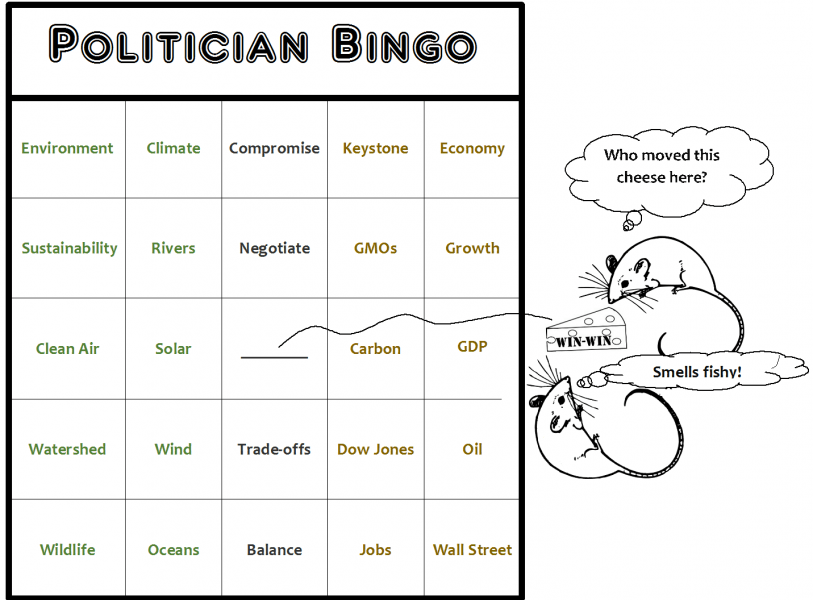Selecting “Surrogate Species” for Conservation: How About an 800-Pounder?
by Brian Czech
 These days the American conservation community is abuzz with the “surrogate species” approach to conservation. That’s where certain species are selected to represent all the others. Older conservation biologists see it as another iteration of the “umbrella species” concept, where managing for a critter like the grizzly bear would automatically protect a long list of species, simply because the grizzly bear occupies a vast sweep of terrain and habitats.
These days the American conservation community is abuzz with the “surrogate species” approach to conservation. That’s where certain species are selected to represent all the others. Older conservation biologists see it as another iteration of the “umbrella species” concept, where managing for a critter like the grizzly bear would automatically protect a long list of species, simply because the grizzly bear occupies a vast sweep of terrain and habitats.
The rationale for taking this approach is clear enough. State and federal wildlife conservation agencies are tasked with conserving thousands of species of concern, including threatened and endangered species, migratory birds, marine mammals, all sorts of fishes and other “aquatic resources,” and biodiversity in general. These species are under pressure from left and right, above and below. Mountaintop removal, shale oil excavation, fracking, helicopter logging, stern trawling, factory farming, manufacturing, road construction, dams, invasive species, air pollution, water pollution, BP oil spills, climate change, genetically modified crops… all greased by the information sectors. “It’s the economy, buddy.”
To protect the thousands of accosted species, one by one, entails dealing with threat after threat after threat, in place after place after place. For a while during the first decade of the 21st century, notions were entertained of doing precisely that! Theoretically we could have worked up some computerized flowchart of species’ population goals, converted all the goals into habitat objectives, melded them all together, and spit out maps identifying precisely which parcels on the landscape were necessary to conserve.
And then of course we would have had to actually go out on the land and protect those parcels. Details!
This whole pipe dream was impossibly complicated, and wouldn’t be possible in the best of fiscal environments. It’s not even close to feasible today as we encounter limits to growth and declining budgets. That’s why we’re back to the umbrella species approach, bottling old wine with a new label, “surrogate species.”
There is another, mostly unspoken rationale for the surrogate species approach. The alternative approach to simplifying conservation — the “coarse filter” approach of conserving various ecosystem types — doesn’t connect so well with publics and politicians. It’s a lot easier to generate political support for a real live critter with fur or feathers than for a “submontane broad-leaved drought-deciduous woodland” or a “succulent extremely xeromorphic evergreen shrubland,” examples of ecosystem types.
Yet either way amounts to basically the same thing. You identify some conservation target — critter or ecosystem — then go out and protect it from the onslaught. Sure, you might have a marginally easier time of it politically by saying you want to protect the bear, wolf, eagle, salmon, black duck, or even some cold-blooded fella such as a desert tortoise. But whether it’s a species or an ecosystem, you either have to stop the economic sectors in their tracks, or buy some land out ahead of the bulldozer and then hope to stop the sectors (and their pollutants) when they reach the gates. That turns out to be not so simple after all. You still have to deal with the mountaintop removal, shale oil excavation, fracking, helicopter logging, stern trawling, factory farming… you get the picture. It’s still the economy, buddy, and it’s getting more unwieldy every day.
It’s time for the conservation community to wake up and smell the notoriety it’s courting for fiddling while Rome burns. If there is a surrogate species in need of attention, it’s the 800-pound gorilla called the economy. It sits there in the corner, growing bigger and more menacing by the day, while conservationists either pretend it doesn’t exist, claim it can grow forever without impacting the environment, or say it’s too big to mess with. None of these three approaches is worth a taxpayer’s dime.

How can we keep ignoring the 800-pound gorilla of economic growth?
If we really want to conserve wildlife and protect the environment, we’d better do exactly the opposite of what we’ve done so far with regard to the 800-pound gorilla. We had better acknowledge the critter, explain to the public why it can’t be reconciled with biodiversity conservation, and not shrink at the thought of it. It is, after all, nothing more than increasing production and consumption of goods and services in the aggregate. It’s measured by the supremely secular GDP. It’s not God, Godzilla, or even (despite the metaphor) King Kong! There’s plenty of precedent in American history for questioning the merits of economic growth, with real effects on public opinion (the demand side of the economy). Real, bold conservationists such as Aldo Leopold and Rachel Carson played a part in this history, as did real politicians such as Robert F. Kennedy and Jimmy Carter.
Conservationists need to learn this history and add a new chapter. Somebody has to lead the way to a new paradigm, away from economic growth and toward the balance of nature. This leadership is just not going to come from Wall Street, the Federal Reserve, or the World Bank. Big-picture leadership is required from conservationists — especially conservation professionals who get paid the big bucks — for developing clear and nuanced public understanding of the trade-off between growing the gorilla and conserving the rest of our fish and wildlife heritage.
Everyone knows that conservation professionals don’t make economic policy. They’re better off not even talking economic policy. But neither did Rachel Carson regulate DDT. Her leadership came in the form of telling the inconvenient truth about organochlorines. The policy implications were obvious. Likewise, leadership to address the 800-pound gorilla starts with rigorous public education. With enough such leadership, citizens will temper consumption from the demand side and economic policy engineers won’t be pulling out all the stops from the supply side. Together — conservationists, citizens, policy makers — we can get that surrogate critter on a sustainable diet!





Good article; fortunately, there are some voices emerging in the environmental community (e.g. Jonathan Porritt and Gus Speth) suggesting this same perspective. Unfortunately, they are an extreme minority.
I enjoyed a modest career as a professional environmental advocate, but finally abandoned that profession when I tired of the pragmatic and effective, but misguided and insufficient, efforts of the best of our current environmental organizations, which are always seeking to placate contemporary capitalism rather than to reform it. They consider the latter task to be too large a task; and I always wondered, “If we don’t do it, who will?” CASSE appears to me to be one of the answers to my query.
I understand, and even admire, the practical work of environmentalists who seek so avidly to establish “win win” policies; but I know that ecosystem integrity will only be protected by reforms of our economic structures such as that proposed by CASSE.
The greatest environmental friend has been rising real incomes. Enhancing environmental sentiments and the virtues of environmental goods is the only realistic way to go. It is not tempering consumption that will work but changing the demand to include consumption of higher quality environmental goods that can work. That said the leadership Mr. Czech advocates in indeed vitally needed.
Fantastic article, yet I continue to marvel at the lack of attention given to the other related *8,000* lb gorilla in the room- global population growth. CASSE has given this 1/2 of the equation some attention in its position statement, but this topic is lacking in many of the CASSE articles that I have come across. No doubt, espousing the merits of a reversal in population growth is an even touchier subject than fiddling with the hallowed “grow, baby, grow!” model of American (Western) capitalism, but we cannot shy away from this half of the equation either. Any theoretical gains made in slowing economic growth could easily be rendered ineffective as the world population climbs and aspires to our Western standard of living.
The Ecological Society of America is in denial over the existence of the ‘gorilla’ and believes we can have unlimited ‘sustainable’ growth (oxymoron). Consequently, I have not renewed my membership of 20 years. It is a shame that the ESA fails to recognize the fundamental relationship between the Laws of Thermodynamics and the concept of ‘unlimited growth’. I would encourage other like minded ESA members to consider informing the ESA board of the implications of the relationship between the Laws of Thermodynamics and the concept of ‘unlimited growth’.
cheers – randy
Brian,
Many thanks for your continuing, valiant efforts to save us from the brink of disaster of our own making. I of course agree with your basic argument (the same argument others have been making at least since George Perkins Marsh stated it, in 1864!), that unrestrained economic growth (e.g., as measured by consumption of resources) will doom us and most if not all other species.
In the hope you might find it helpful, and in the hope it might ultimately benefit nonhuman species, but recognizing it is at least on the surface a minor, technical question, please let me ask whether you would extend this argument to include growth in the economy of habitat “restoration”. (I put “restoration” in quotes because I think “maintenance” is generally a more appropriate term; for example, as I trust you’ve seen from work by Wilcove and Chen [1998] and Scott et al. [2010], the survival of a majority of ESA-listed species now depends on active management by humans for the foreseeable future, such as to control invasive species or reproduce historic burning by Native Americans.)
Again, I appreciate that the restoration economy is barely measurable relative to the global economy. Yet to the extent “your” (i.e., our!) argument is premised on the goal of conserving nonhuman species, I’d like to think this question has some merit, if only as matter of philosophy (though I sincerely see it as a serious question for economic theory and conservation policy). Specifically, I hope that if it raises an exception to the rule, the exception might help clarify and strengthen the rule, such as by helping reduce political opposition to governmental constraints on growth, by potentially helping avoid or remove constraints that are counterproductive to the survival of species.
To share some background on how I come to ask this question, I include below a current abstract of my thesis (in progress).
In any case, I thank you again for your efforts.
Best regards,
–Adam
Adam Novick
Master’s degree student
Environmental Studies Program
University of Oregon
Disclaimer: Any views expressed here are not necessarily those of the University of Oregon.
PS. Works cited:
Scott, J. Michael, Dale D. Goble, Aaron M. Haines, John A. Wiens, and Maile C. Neel. 2010. Conservation-reliant species and the future of conservation. Conservation Letters 3: 91- 97.
Wilcove, David S., and L. Chen. 1998. Management costs for endangered species. Conservation Biology 12: 1405-1407.
PPS. My abstract:
* * *
Risk to maintenance-dependent species from orthodoxy in species-based land-use regulation
I theorize and present some evidence that humans inadvertently risk exacerbating the loss of maintenance-dependent species on private land by using species-based land-use regulation to seek other benefits. Through participant-observation and works by others, I argue that such regulation poses a risk to maintenance-dependent species, that humans routinely disregard this risk, and that this disregard widely serves to defend the power of individuals and organizations to use such regulation to seek other benefits. I suggest this implies that with constraints on public funding, humans might improve species survival by clarifying the purpose of such regulation and considering openly refraining from such regulation for some species. I also suggest such change might depend on articulating the issue as whether species survival could ever depend on individuals having a right to conserve or maintain a species without selectively incurring harm from regulation intended to save it.
* * *
Perhaps I am far too cynical, but I suspect the cultural denial of the gorilla is partially due to CASSE making entirely TOO much sense. I think this common sense stymies our society, politicians, economists, and even the likes of the Ecological Society of America.
Don’t be afraid, common sense does not really hurt, it is our friend.
best regards – randy